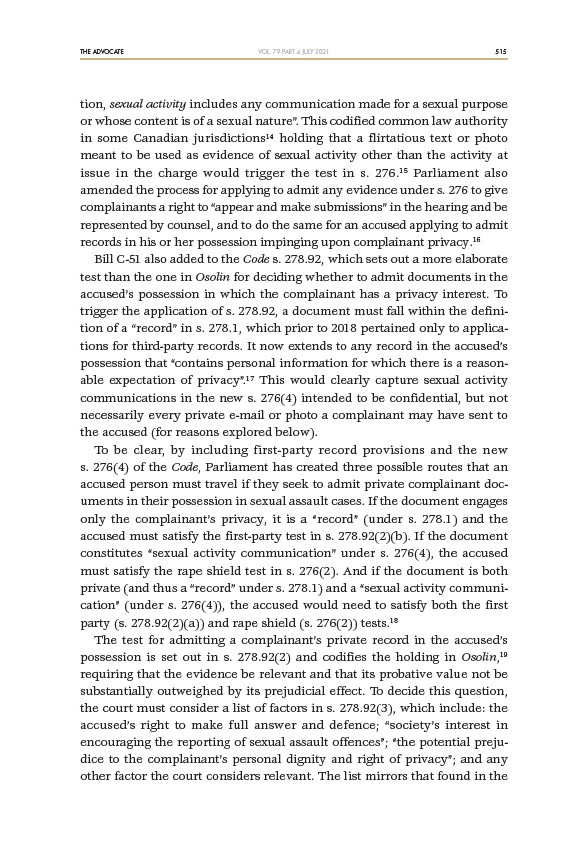
THE ADVOCATE 515
VOL. 79 PART 4 JULY 2021
tion, sexual activity includes any communication made for a sexual purpose
or whose content is of a sexual nature”. This codified common law authority
in some Canadian jurisdictions14 holding that a flirtatious text or photo
meant to be used as evidence of sexual activity other than the activity at
issue in the charge would trigger the test in s. 276.15 Parliament also
amended the process for applying to admit any evidence under s. 276 to give
complainants a right to “appear and make submissions” in the hearing and be
represented by counsel, and to do the same for an accused applying to admit
records in his or her possession impinging upon complainant privacy.16
Bill C-51 also added to the Code s. 278.92, which sets out a more elaborate
test than the one in Osolin for deciding whether to admit documents in the
accused’s possession in which the complainant has a privacy interest. To
trigger the application of s. 278.92, a document must fall within the definition
of a “record” in s. 278.1, which prior to 2018 pertained only to applications
for third-party records. It now extends to any record in the accused’s
possession that “contains personal information for which there is a reasonable
expectation of privacy”.17 This would clearly capture sexual activity
communications in the new s. 276(4) intended to be confidential, but not
necessarily every private e-mail or photo a complainant may have sent to
the accused (for reasons explored below).
To be clear, by including first-party record provisions and the new
s. 276(4) of the Code, Parliament has created three possible routes that an
accused person must travel if they seek to admit private complainant documents
in their possession in sexual assault cases. If the document engages
only the complainant’s privacy, it is a “record” (under s. 278.1) and the
accused must satisfy the first-party test in s. 278.92(2)(b). If the document
constitutes “sexual activity communication” under s. 276(4), the accused
must satisfy the rape shield test in s. 276(2). And if the document is both
private (and thus a “record” under s. 278.1) and a “sexual activity communication”
(under s. 276(4)), the accused would need to satisfy both the first
party (s. 278.92(2)(a)) and rape shield (s. 276(2)) tests.18
The test for admitting a complainant’s private record in the accused’s
possession is set out in s. 278.92(2) and codifies the holding in Osolin,19
requiring that the evidence be relevant and that its probative value not be
substantially outweighed by its prejudicial effect. To decide this question,
the court must consider a list of factors in s. 278.92(3), which include: the
accused’s right to make full answer and defence; “society’s interest in
encouraging the reporting of sexual assault offences”; “the potential prejudice
to the complainant’s personal dignity and right of privacy”; and any
other factor the court considers relevant. The list mirrors that found in the